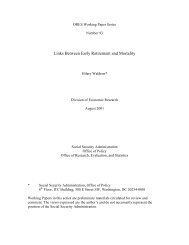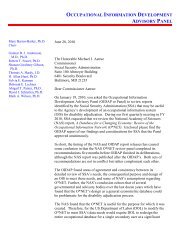Table 6.Estimated occupational distributions of the employed population with work disabilities, by occupationalchoicemodel aOccupationSSI recipientsNon-SSI recipients with—No disability Any disability Work disabilityTotal 100.00 100.00 100.00 100.00Management, professional, and related 20.10 28.56 23.48 23.48Management 3.60 8.93 5.86 5.86Business and financial operations 2.49 3.67 3.03 3.03Computer and mathematical, architecture andengineering, life, physical and social science 1.01 3.85 2.93 2.93Community and social services 1.33 1.25 1.56 1.56Legal 0.54 0.85 0.67 0.67Education, training, and library 4.25 4.11 3.78 3.78Arts, design, entertainment, sports, and media 3.96 1.53 1.53 1.53Health-care practitioner and technical 2.93 4.37 4.12 4.12Service 30.05 17.39 22.76 22.76Health-care support 2.39 2.49 3.22 3.22Protective service 1.75 2.08 2.26 2.26Food preparation and serving related 5.53 4.97 6.20 6.20Building and grounds cleaning and maintenance 10.67 4.46 6.49 6.49Personal care and service 9.72 3.38 4.60 4.60Sales and office 23.07 26.47 24.44 24.47Sales and related 7.92 10.84 10.65 10.65Office and administrative support 15.15 15.63 13.79 13.79Farming, fishing, and forestry 0.49 0.67 0.75 0.75Construction, extraction, maintenance, and repair 5.21 11.33 11.22 11.22Production, transportation, and material moving 21.07 15.58 17.36 17.36Production 8.29 8.23 8.33 8.33Transportation and material moving 12.77 7.35 9.03 9.03SOURCE: Author's calculations using the 2007 American Community Survey.NOTES: The sum of individual categories may not equal the total because of rounding.a. The occupational-choice models are based on separate multinomial logit regressions of occupation for each population group.Covariates in all models include sex, ethnicity, race, marital status, education, age, and age squared. The disabled, work-disabled, andworking-SSI models also include disability type as additional covariates. All estimates use ACS balanced repeated replicate sampleweights. See Table A-3 for the results of the models.There is an increase in the percent of these populationsin service occupations under the working-SSImodel—21 percent to 28 percent for those with adisability (Table 4), 16 percent to 25 percent forthose without a disability (Table 5), and 23 percent to30 percent for those with a work disability (Table 6).This is largely due to increases in the percentageworking in building and grounds cleaning and maintenanceoccupations. Construction, extraction, maintenance,and repair occupations also see large declines,as would be expected given the results in Table 3.The concentration of predicted occupations somewhatfollows that of the actual occupations (Table 7,panel A). The working SSI recipient occupationalchoicemodel yields the highest concentration ofoccupations for all groups. Additionally, under eachmodel, working SSI recipients have the highest HHI,reflecting more concentrated distributions. Theoccupational concentrations are not lowest under theno-disability occupational-choice model, as might beexpected, although people without disabilities have thelowest concentrations under each model, other thanthe working SSI recipient model. However, all threenonrecipient models yield similar HHI values.Controlling for demographic characteristics, humancapital, and disability type greatly reduces the dissimilaritybetween the distributions of the variousgroups (Table 7, panel B). Compared with Table 2, the58 <strong>Social</strong> <strong>Security</strong> Bulletin • Vol. 69 • No. 3 • 2009
Table 7.Predicted Herfindahl-Hirschman and occupational dissimilarity indices of the employed population underalternative occupational-choice modelsEstimated populationSSI recipient modelNon-SSI recipient models with—No disability Any disability Work disabilityPanel A: Herfindahl-Hirschman indexSSI recipients 1,089.90 898.38 865.27 876.76Non-SSI recipientsNo disability 915.44 774.93 765.34 735.94Any disability 865.66 825.35 795.82 797.31Work disability 863.78 827.50 786.49 786.49Panel B: Dissimilarity index of comparison group and modelSSI recipients 0.00 16.70 12.14 10.44Non-SSI recipientsNo disability 25.82 0.00 8.40 6.89Any disability 20.66 6.61 0.00 2.07Work disability 18.83 7.24 3.77 0.00SOURCE: Author's calculations using the 2007 American Community Survey.NOTE: Herfindahl-Hirschman indices are calculated for each row group's estimated distribution under the column group's occupationalchoicemodel. Dissimilarity indices are calculated between the estimated distribution of the row group under the model based on the columngroup and the column group's actual distribution. This is the proportion of the two groups that would need to change occupations for there tobe parity between the occupational distributions of the two groups.differences between the occupational distributions ofeach of the control populations and the SSI populationare halved. Only 17 percent of the populationwould need to change occupations to equalize thedistributions of those receiving SSI and those withouta disability under the no-disability model. Under thedisability and work-disability models, the difference iseven smaller (12 percent and 10 percent of the population,respectively). Under the working SSI recipientmodel, the difference between the working SSI populationand each group is larger than under the othermodels, and the difference from the actual distributionis much smaller for each group.Predicted Occupations of UnemployedSSI RecipientsAlthough the above results present the current occupationaldistributions and how much any differencescan be explained away by demographic characteristics,human capital, and disability type, much ofSSA’s interest in return to work is in getting those notemployed into the labor force and employed. Estimatesof the occupations the unemployed and non–laborforce participant (non-LFP) SSI recipients would haveif they were employed under each of the models aboveare presented in Tables 8 and 9, respectively. Theseestimates do not consider any effect the return to workwould have on the larger distribution of occupationsor for selection into the labor force. As a result, theseestimates may under or overstate the proportion ofrecipients in each occupational group.The predicted occupations of unemployed andnon-LFP SSI recipients are very similar to those ofworking SSI recipients under any occupational-choicemodel (see Table 3 for comparison). For the unemployedSSI population, the most common predictedoccupations are in office and administrative support(14 percent to 16 percent); sales and related occupations(about 11 percent); and construction, extraction,maintenance, and repair occupations (10 percent to12 percent). Non-LFP SSI recipients are also wellrepresented in these occupations. As with the workingSSI population, many unemployed and non-LFPSSI recipients are predicted to work in building andgrounds cleaning and maintenance or food preparationand serving-related occupations. In fact, serviceoccupations comprise about 30 percent of predictedoccupations in all but the no-disability occupationalchoicemodel for both groups.The HHI values for the predicted occupationaldistributions are similar to those of the workingSSI population reported in Table 7 (see Table 10,<strong>Social</strong> <strong>Security</strong> Bulletin • Vol. 69 • No. 3 • 2009 59
- Page 1 and 2:
Social SecuritySocial SecurityBulle
- Page 3:
Social SecurityBulletin Vol. 69, No
- Page 6 and 7:
Perspectives77 An Empirical Study o
- Page 8 and 9:
Selected Abbreviations—continuedM
- Page 10:
within the next few years (Aglira 2
- Page 14 and 15: coverage varies significantly by ra
- Page 16 and 17: non-Hispanic white, and college edu
- Page 18 and 19: same groups (Table 6). For the last
- Page 20 and 21: from DB to DC pensions is accelerat
- Page 22 and 23: Table 8.Percent of individuals who
- Page 24 and 25: not necessarily the largest gains a
- Page 26 and 27: shoring-up DB plans before those pl
- Page 28 and 29: Table B-1.Percent change in mean pe
- Page 30 and 31: Table B-3.Percent of individuals wh
- Page 32 and 33: ReferencesAaronson, Stephanie, and
- Page 35 and 36: Social Security Administration’s
- Page 37: Chart 1.Historical expansion of Soc
- Page 40 and 41: self-employment information for the
- Page 42 and 43: (Cronin 1985). The final earnings r
- Page 44 and 45: prior to 1950, first year of earnin
- Page 46 and 47: average indexed monthly earnings (A
- Page 48 and 49: 13For an explanation of how the sel
- Page 50 and 51: Kopczuk, Emmanuel Saez, and Jae Son
- Page 53 and 54: Occupations of SSI Recipients Who W
- Page 55 and 56: on the differences between the occu
- Page 57 and 58: prediction models. Table A-1 lists
- Page 59 and 60: Occupational Distributions of theEm
- Page 61 and 62: similar, only 4 percent of the popu
- Page 63: Table 5.Estimated occupational dist
- Page 67 and 68: Table 9.Estimated occupational dist
- Page 69 and 70: Table 11.Average annual wages of wo
- Page 71 and 72: Table A-2.Means and standard errors
- Page 73 and 74: Table A-3.Coefficients and standard
- Page 75 and 76: Table A-3.Coefficients and standard
- Page 77 and 78: Table A-3.Coefficients and standard
- Page 79 and 80: management, professional, and relat
- Page 81: Stapleton, David C., Nanette Goodma
- Page 84 and 85: Selected Abbreviations—continuedO
- Page 86 and 87: The 1983 Amendments to the Social S
- Page 88 and 89: Chart 1.Proportion of new claimants
- Page 90 and 91: Table 4.The evolution of the ARF an
- Page 92 and 93: for the test of equality of means b
- Page 94 and 95: Table 8.Average monthly Social Secu
- Page 96 and 97: in the chart, especially for men, t
- Page 98 and 99: 6This is a very important character
- Page 100 and 101: Benítez-Silva, Hugo, Berna Demiral
- Page 103 and 104: OASDI and SSI Snapshot andSSI Month
- Page 105 and 106: Monthly Statistical Snapshot, Augus
- Page 107 and 108: Table 2.Recipients, by eligibility
- Page 109 and 110: SSI Federally Administered Payments
- Page 111 and 112: Table 7.Average monthly payment, by
- Page 113: Awards of SSI Federally Administere
- Page 116 and 117:
Copyright—Authors are responsible
- Page 119 and 120:
Program Highlights, 2009Old-Age, Su








